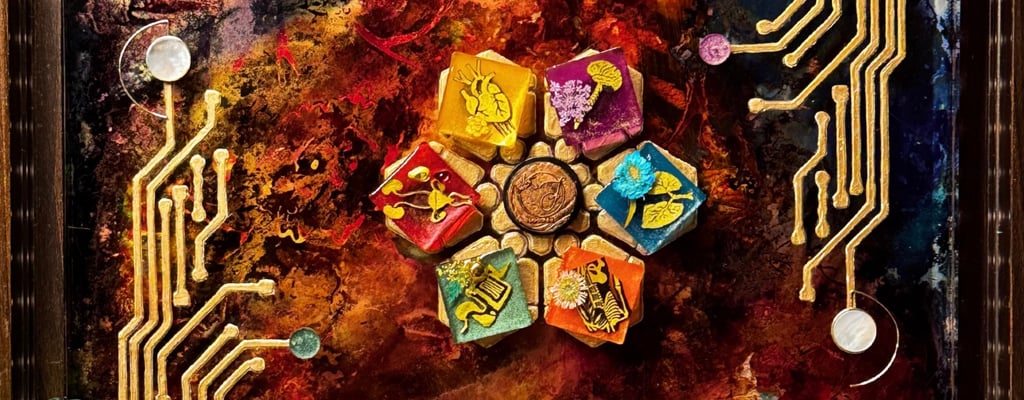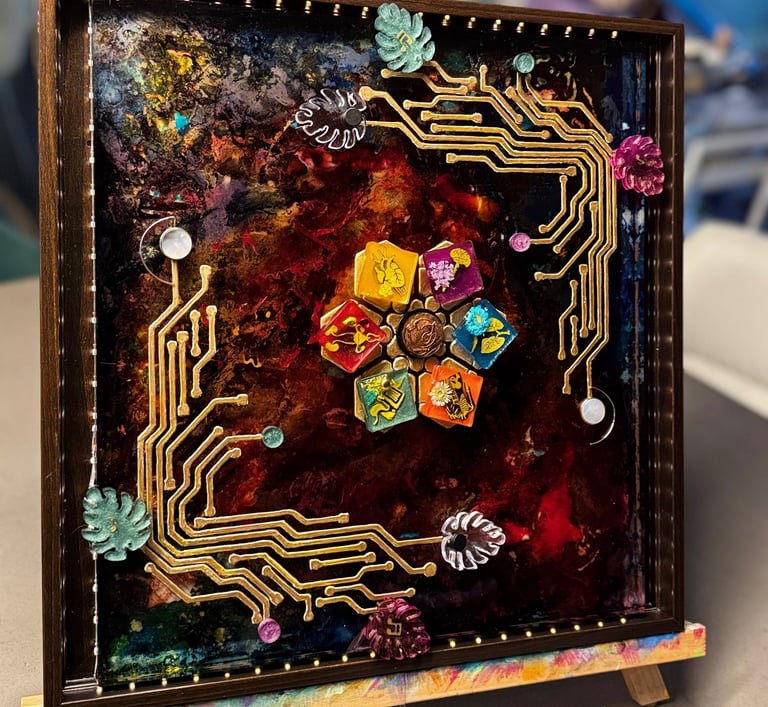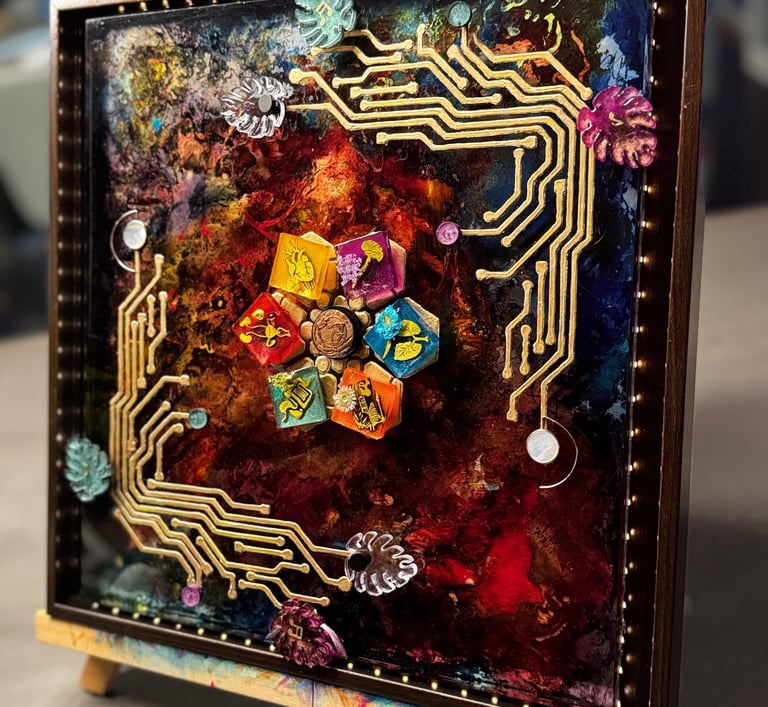The Fellowship of My Mind
Adding context to the visual.
Fermionne
11/24/20254 min read


It was a crisp November morning in 2020, the clock had just hit 3:42 a.m.—time for Bellatrix to transmit her nightly encrypted message: a two-beat ticking. The phenomenon had started a few nights earlier, around the same time an Orion-shaped mark appeared on my left cheek, tucked beneath the crease of my extra-dark circles and perched above the zygomatic arch. Bellatrix’s star position seemed to pinch at the exact moment when the signal was transmitted. I obsessed over what she might be trying to tell me—and what it would take to break the encryption. What could all of this mean? I was heavily invested in my adventure.
Then reality—ever sardonic—intervened. My observer offered a blunt little verdict:
“So this is what it feels like to go completely insane.”
When I asked the observer to elaborate, they offered four matter-of-fact truths:
The cheek pattern was acne, from a furious, bleeding gut rejecting the NSAID Meloxicam with formidable conviction.
The “ticking message” was the HVAC system settling into heater mode, and for some reason ticks exactly at 3:42 am.
My sci-fi adventure was a Prednisone-induced psychosis.
Escapism was a lovely alternative to my seemingly insurmountable reality.
To make things exponentially worse, my Vipassana practice had sharpened, which meant I was now experiencing psychosis… consciously. Not for the faint of heart. It entailed seven months of thirty-minute-a-night sleep, Herculean efforts to not buy into the conspiracy theories my mind was concocting, and a body trembling like a malfunctioning engine.
With a deeply dissociated Joker-like grin and childlike folly, I told my therapist—my whole saga, the same broken-record montage that’d been holding me hostage.
She didn’t flinch. She invited me to lean into the crash with a tool called Internal Family Systems (IFS).
Oversimplification of IFS: a technique for identifying your internal “parts” and accepting them as though they are members of an inner family.
I liked that it was an evidence-based way to manage my inner cray-cray.
Before I met IFS, my internal dialogue looked something like this:
Mind: I’m not giving up my career for “health.”
Body: Cool. Watch me shut down.
Mind: FUUUUUU—
Body: Lights off. Spine out. Good luck.
Career: dead.
Corporate America: “Come back healthy or not at all.”
Me: sigh, Fine.
Here’s the silver lining bit, though: I had finally identified two dominant "parts", myself and the body. The issue was that we were at war with one another.
Terrified by psychosis and humbled by the ashes of my former life, I finally chose pragmatics over pride and decided to make changes. The body got its first victory in years.
The first order of the truce: whatever data model I built next had to be grounded in reality. I was going to forsake my vivid fictional dreamscapes and replace them with hard, objective observations.
A few years in, armed with labeled/contextualized data and a far superior internal noise-cancellation algorithm, I got better at discerning the “voices in my head” and logically classifying them. As the language layer disentangled from causality, explicit patterns emerged. It took me a while, but I finally had the epiphany that the patterns were my organ systems, trying to communicate. I had been a terrible god to my inner world— a tyrant in a meat suit. Prioritizing “success” with some mind-over-matter BS, devaluing the one material belonging I truly have: my body. I was filled with such regret and remorse.
As a peace offering, I handed her a blank canvas and switched into listen-only mode—
And boom: a direct line of communication opened. She was willing to let me in. She gave me access to:
Her patterns.
Her layers.
Her organ systems
Pleading in cubicles of flesh.
Waiting, almost desperately
To be heard,
To be nourished,
To be held,
To be loved.
In a reversal of intent, the atonement efforts took center stage, and I established a Fellowship.
Rewired the motherboard.
Built a council.
An executive committee.
A democracy of organs.
To contextualize their patterns.
And synchronize my actions.
In service of my body.
These days, the meetings go like this—
Kali (Digestive System), Chief Financial Officer: Lupus has a 55–85% resource utilization. Apart from gluten, I need us to quit sugar and dairy. That will free up resources to stay functional and make half-decent art.
Ramona (Nervous System), Chief Technology & Product Officer: How about I just head to the assisted-suicide facility? We already quit alcohol. The quality of life leaves much to be desired.
Little Girl (Cardiovascular System), HR: Ramonaaaa. We’ve already made the choice—to be. Stop with the morbid jokes. How about some concessions for special occasions, Kali? Let’s quit gluten for good (obviously, allergies), but sugar and dairy sometimes? Pwwetty please?
Kali: That’s doable, Little Girl.
Tula (Musculoskeletal System), Chief Operations Officer: Agree with Kali. Sugar and dairy make everything achy and inflamed. But sometimes, a delicious something-something is worth the pain.
Aura (Respiratory System), Chief Communications Officer, steps in with three deep breaths: Let’s keep it light and breezy. When Tula is happy, I can breathe happy. So I'm in.
Woman (Urogenital System), Head of Mergers & Acquisitions: Over my dead ovaries! Until rape is extinct, my feminine rage keeps raging, and I want my supply of dark chocolate to regulate that murderous rage.
Everyone: Okay, let’s take a vote.
Bill passed: Quit gluten, and drastically limit dairy and sugar with periodic dark chocolate supplies for Woman.
Yes, the workplace is still quite toxic. Yes, I have achieved cold war status with a fragile democracy for now. Yes, I’m working on inner-world peace through a benevolent approach, whatever that means.
Until then, enjoy the imperfect Fellowship of my Mind. May the internal committees remain messy
and mercifully alive.






